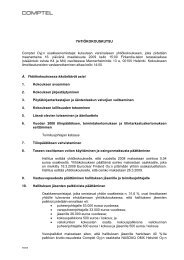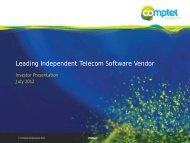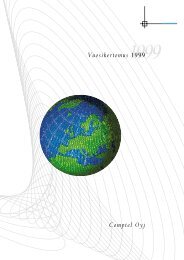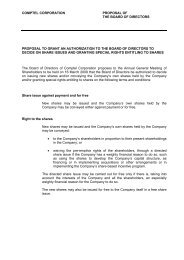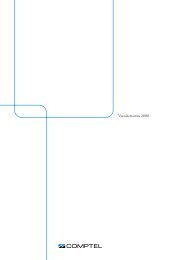Financial Report - Comptel
Financial Report - Comptel
Financial Report - Comptel
Create successful ePaper yourself
Turn your PDF publications into a flip-book with our unique Google optimized e-Paper software.
entity are measured using the currency<br />
of the primary economic environment in<br />
which the entity operates (functional currency).<br />
The consolidated financial statements<br />
are presented in euro, which is the<br />
functional and presentation currency of the<br />
parent company.<br />
Transactions in foreign currencies<br />
are translated at the exchange rates prevailing<br />
on the dates of the transactions. Foreign<br />
currency monetary balances are translated<br />
at the closing rate at the balance sheet date.<br />
Non-monetary items measured at fair value<br />
in a foreign currency are translated at the<br />
closing rate at the balance sheet date. Gains<br />
and losses resulting from transactions in<br />
foreign currencies and translation of monetary<br />
items are recognized on the income<br />
statement.<br />
if they differ from previous estimates, the<br />
amortization period is changed accordingly.<br />
Identifiable intangible assets acquired<br />
on a business combination are measured<br />
at fair value. Such intangible assets<br />
relate to client relationships and technolosets<br />
and liabilities of the acquired entity and<br />
are translated at the closing rate.<br />
Property, plant and equipment<br />
Items of property, plant and equipment<br />
are stated at historical cost less cumulative<br />
depreciation and any impairment losses.<br />
Where parts of an item of property, plant<br />
and equipment have different useful lives,<br />
they are accounted for as separate items of<br />
property, plant and equipment. Depreciation<br />
is charged to the income statement<br />
on a straight-line basis over the estimated<br />
useful lives of each part of an item of property,<br />
plant and equipment. The depreciation<br />
period for machinery and equipment<br />
is four years.<br />
Maintenance, repairs and renewals<br />
are generally expensed during the financial<br />
period in which they are incurred except<br />
for large renovation expenditure relating to<br />
leased premises that are capitalized under<br />
property, plant and equipment. Such costs<br />
are depreciated over the shorter of five years<br />
and the lease term.<br />
Residual values of property, plant<br />
and equipment and expected useful lives<br />
are reassessed at each balance sheet date<br />
and where necessary are adjusted to reflect<br />
the changes in the expected future economic<br />
benefits.<br />
Property, plant and equipment classified<br />
as held for sale in accordance with IFRS<br />
5 Non-current Assets Held for Sale and Discontinued<br />
Operations are not depreciated<br />
after the classification as held for sale.<br />
Gains and losses on sales and disposals<br />
of property, plant and equipment are<br />
included in operating income and in operating<br />
expenses, respectively.<br />
Intangible assets<br />
Goodwill<br />
After 1 January 2004 goodwill represents<br />
the Group’s share of difference between the<br />
cost of the acquisition and the fair value<br />
of the net identifiable assets, liabilities and<br />
contingent liabilities acquired measured at<br />
the acquisition date. Goodwill arisen from<br />
the business combinations occurred prior<br />
to the IFRS transition date has been accounted<br />
for in accordance with FAS and has<br />
<strong>Financial</strong> statements<br />
of foreign subsidiaries<br />
Income statements and cash flows of foreign<br />
subsidiaries are translated into euro at<br />
the weighted average exchange rate during<br />
the financial period. Their balance sheets<br />
are translated at the closing rate at the balance<br />
sheet date. The translation differences<br />
arising from the translation of the profit for<br />
the period by using the average and closing<br />
rates are recognized as a separate item in<br />
equity. The translation differences arising<br />
from the use of the purchase method and<br />
after the date of acquisition as well as the<br />
result of the hedge of a net investment in<br />
a foreign operation are recognized in equity.<br />
If a subsidiary is disposed of, related<br />
cumulative translation differences deferred<br />
in equity are recognized on the income<br />
statement as part of the gain or loss on sale.<br />
From the transition date onwards translation<br />
differences arising on the consolidation<br />
are presented as a separate component<br />
of equity.<br />
Goodwill and fair value adjustments<br />
to assets and liabilities that arose on an acquisition<br />
of a foreign entity occurred prior<br />
to 1 January 2004 are translated into euro<br />
using the rate that prevailed on the date<br />
of the acquisition. Goodwill and fair value<br />
adjustments arisen on an acquisition after<br />
1 January 2004 are treated as part of the asbeen<br />
taken as a deemed cost.<br />
In accordance with IAS 36 Impairment<br />
of Assets goodwill is not amortized but<br />
tested for impairment annually. Goodwill is<br />
stated at cost less any cumulative impairment<br />
losses.<br />
Research and development costs<br />
In accordance with IAS 38 Intangible Assets<br />
expenditure on research activities is recognized<br />
as an expense in the period in which<br />
it is incurred. Development costs that arise<br />
from design of new or improved products<br />
are capitalized as intangible assets in the<br />
balance sheet when the product is technically<br />
and commercially feasible and it will<br />
generate future economic benefits. Amortization<br />
of such an asset is commenced when<br />
it is available for use. Unfinished assets are<br />
tested annually for impairment.<br />
<strong>Comptel</strong> capitalizes development<br />
costs and costs related to internal system<br />
projects meeting the requirements under<br />
IAS 38. Capitalized development costs are<br />
amortized on a straight-line basis over three<br />
years and the costs related to internal system<br />
projects over four years, respectively.<br />
Government grants that compensate<br />
the Group for the development costs are either<br />
deducted from the carrying amount of<br />
the asset or from the related expenses in the<br />
income statement.<br />
Other intangible assets<br />
Patents and licences acquired as well as<br />
costs incurred from patent applications<br />
with a finite useful life are capitalized and<br />
amortized on a straight-line basis over their<br />
useful lives. Amortization is calculated<br />
based on the original cost and allocated<br />
over the useful life.<br />
The capitalized patent costs are generally<br />
amortized over ten years and licences<br />
over four years, respectively.<br />
The expected amortization periods<br />
are reviewed at each balance sheet date and<br />
21<br />
Notes to the Consolidated <strong>Financial</strong> Satements



